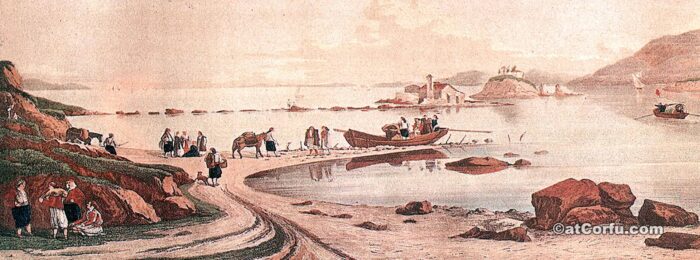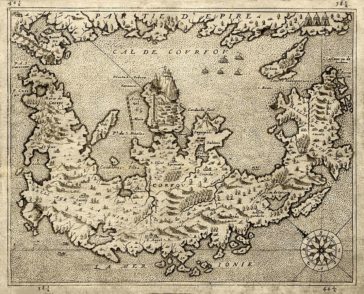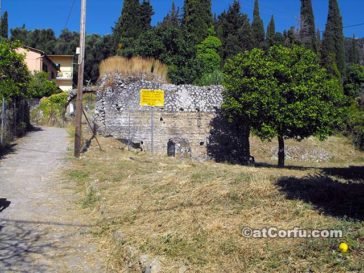Last updated on June 25th, 2025 at 01:52 pm
The Venetian domination in Corfu, 1386 – 1797CE

Venetian Rule: Purchase and Unusual Resistance
During the Council of Corfu, a significant majority of the nobility favored Venetian protection due to the crumbling Byzantine Empire and the constant Turkish threat. In 1386 CE, the Council officially sought refuge with the Republic of Saint Markos (Venice).
Recognizing Corfu’s strategic importance and agricultural potential, the Venetians purchased the island from the Kingdom of Naples for 30,000 gold ducats. Venetian forces, led by “Admiral of the Gulf” Giovanni Miani, landed in Corfu.
This turbulent time lacked a strong sense of national identity, leading to unusual events. While Venetians occupied the Old Fortress without resistance and dominated most of the island, the Angevin-controlled fortresses of Angelokastro and Kassiopi in the north opposed the sale. Residents, supporting the Angevins, fought against the Venetians.
In response, Venetians sent an army to capture both fortresses. Angelokastro surrendered quickly, but Kassiopi resisted fiercely. The Venetians, angered by this resistance, destroyed the Kassiopi fortress, leaving only remnants today.
This marked the start of the second extended period of Venetian rule in Corfu, lasting precisely 411 years, 11 months, and 11 days.

The constitution during the Venetian domination
The Venetian rule in Corfu established a feudalistic system with three social classes: nobility, citizens (Civili), and poor people (called Popolari). The painting of medieval Corfu, now Evgenios Voulgaris Street, shows a snapshot of life, with little change over time.
Agriculture thrived with olive tree cultivation, and Corfu’s connections with great empires boosted arts and sciences. The Venetian era profoundly impacted Corfu, influencing art, music, culture, local language, cuisine, and architecture.
Corfu’s constitution during the Venetian occupation was exclusive, concentrating political power in the hands of the local nobility. Venetians with political influence included the General Proveditor of the Sea and his Judiciary. The Golden Book listed local nobles, granting privileges.
During the second Ionian state, only those in the Libro d’Oro enjoyed Liston area privileges. Originally, Byzantine names dominated, later joined by affluent civilians supporting the state treasury. Today, many city names trace back to this list, with a few from villages.

The migration flow from Turkish-occupied Greece
The Venetians, while securing Corfu city, struggled to protect the countryside, leading to tragedies during barbarian raids and pirate attacks, notably Turkish invasions in 1537 and 1571.
In 1537, the Turks invaded, capturing and selling 20,000 countryside men as slaves. Greeks from the Peloponnese, Epirus, and Crete migrated to Corfu, rebuilding the depopulated areas.
In 1571, Venetians lost the Peloponnese, Crete, and Cyprus, prompting a refugee influx to Corfu. The Venetians encouraged migration to repopulate and attract skilled individuals, weakening the Ottomans and strengthening Venice.
Refugees from Nafplio and Monemvasia settled in Lefkimi, Pirgi to Kassiopi, and south of Nissaki (Barbati), shaping the island’s demographics.
Peloponnesian immigrants founded Moraitika and Korakiana, contributing to the prevalence of surnames like Moraitis and “opoulos.”
Cretan immigrants impacted Garitsa, Saint Markos, Stroggyli, Messonghi, Argyrades, and Kritika, influencing Corfu’s linguistic idiom with unique pronunciations.
Despite these influences, Corfu’s culture remained resilient, incorporating new elements, and the immigrants eventually integrated into the Corfiots’ lives. In 1800, Souli refugees settling in Benitses became a significant part of the population after Ali Pasha’s destruction of Souli.

The Venetian fortifications and the frequent Turkish raids
The Venetians, unable to convert Corfu to Catholicism, prioritized political stability and coined the phrase “Siamo prima Veneziani e poi Cristiani” (We are first Venetians and then Christians). To promote harmony, they organized joint religious events for both Catholics and Orthodox Christians, continuing traditions today.
With public discontent due to Turkish threats, especially after losing Crete and Cyprus, Corfu became crucial to Venice. The Venetians, determined to fortify the island, undertook ambitious plans from 1576 to 1588.
They built the San Marcos fortress on the west hill, creating the vast Esplanade Square in front of the old fortress. Connecting them with a protective wall featuring bastions like Raimondo and St. Athanasius, they added gates like Porta Reale, Porta Raymonda, Gate of Spilia, and Gate of Saint Nicholas, enhancing defenses.
Engineers Michele Sanmicheli and Ferrante Vitelli designed these fortifications, evolving over the 17th century. After repelling the Turks in 1716, Marshal Johann Matthias von Schulenburg added another wall outside, designed by F. Verneda.
Post the 1716 Turkish invasion, Vido Island, Avrami and Saint Sotiros hills, and the San Rocco (Saroko) area were fortified, ensuring Corfu’s robust defense.

The Turkish Siege of 1716
The 1716 siege of Corfu marked a pivotal moment in the Seventh Venetian-Turkish War, with the island’s occupation viewed as a potential threat to Venice and Europe.
The Turkish forces, numbering 25,000-30,000, supported by 71 ships and about 2,200 guns, posed a formidable challenge. In contrast, the Venetians, with only 3,097 men (2,245 combatants), faced a significant numerical disadvantage.
Defending the Corfu New Fortress, Marshal Johann Mattias Von Schulenburg dealt with initial chaos among locals seeking refuge. He quickly recruited able-bodied individuals, bolstered reservists, and lifted the besieged morale.
Starting on July 8th and concluding after fierce battles on August 22nd, the siege witnessed a turning point on August 20th when a storm scattered Turkish ships, leading to significant losses. While Corfu credited St. Spyridon for the storm, military factors, including the Ottoman army’s defeat in Peterwardein, played a crucial role in the Turks’ retreat.
Casualties included around 800 dead and 700 wounded defenders, contrasting with substantial Turkish losses, totaling 6,500 men, including Muchtar, Ali Pasha’s grandfather.
A diverse coalition supported Corfu’s defense, comprising Venetians, Germans, Italians, Maltese, Papal, Genoese, Tuscan, Spanish, and Portuguese forces, showcasing the unity that secured victory.

Corfu’s Heroic Stand: Defying the Ottoman Tide in 1716
During the conflict, the Jewish community in the city exhibited remarkable courage, mobilizing under the leadership of the Rabbi’s son, equipped through the Corfiot Jewish community’s resources.
Antrea Pizanis, the General Proveditor of Corfu, commanded the light fleet and served as Marshal Schulenburg’s adjutant. The key role played by Corfiot Lieutenant Dimitrios Stratigos added to the cohesive defense.
Marshal Schulenburg’s unwavering determination earned him a lifelong pension from the Senate of Venice, with his statue adorning the Old Fortress entrance.
All those who displayed bravery in the conflict received due recognition and honors.
The Turkish setback in Corfu held historic significance, altering the trajectory of Europe’s history, especially for Greece. The bravery of the Corfiots and Europeans played a crucial role in preventing the potential expansion of the Ottoman Empire and influencing the emergence of the Greek nation.
Unfortunately, this event often goes unrecognized by historians, despite its pivotal role in shaping the present-day Greek state. The successful repulsion of the Turkish invasion in 1716 carried great importance for Western Europe, marked by grand celebrations and even inspiring Antonio Vivaldi’s oratorio “Juditha Triumphans,” performed in major theaters for years.
This event marked the final Turkish attempt to expand into Europe.
The Venetian era, while leaving positive cultural legacies, faced challenges such as strained relations between commoners and the nobility. Uprisings, particularly in villages, resulted from the Venetian ruling class’s authoritarianism and arbitrary behavior.
Corfu remained a significant part of the Venetian State until the fall of Venice to the French, showcasing its enduring importance to Venice.

Ioannis Kapodistrias and his role in the History of Corfu
Ioannis Kapodistrias, the first governor of modern Greece, was born on the island into an aristocratic family. After pursuing education, he rose to prominence in Russia, eventually becoming a foreign minister and actively participating in European political affairs.
His notable achievements included contributions to the formation of Switzerland’s state entity and constitution, earning him recognition from the Swiss.
While Kapodistrias had limited involvement in Corfu’s historical course, playing a diplomatic role in its liberation from French rule by a Russian-Turkish alliance in 1800, his overall connection with the island’s history is not extensive. Despite his ties to Corfu being somewhat limited, his diplomatic contributions are worth acknowledging.
(Note: Historical alliances between Russia and Turkey, despite fluctuations, have been observed in various instances. This might be relevant for those with an affinity for Russia.)
More about History
Corfu: Union With Greece and Modern Times
On the 21st of May 1864, the British ruled Corfu and together with all the Ionian Islands, following the London Agreement and the Ionian Parliament’s resolution, united with Greece
Corfu of the Middle Ages on a Map of 1575
This map of Corfu of 1575 was designed like all medieval maps. According to the sources of that time and lots of imagination
Corfu at Prehistoric and Ancient Times
Corfu has been inhabited since the Stone Age.
At that time it was part of the mainland and the sea that today separates it from the mainland was only a small lake
Roman Era and Early Byzantine Period
At the time of emperor Theodosius (339 AD), the Roman empire was re-divided into east and west, Corfu then belonged to the east empire
Corfu Middle Ages and Byzantine Period
During this period the whole island was exposed to frequent barbarian raids and pirate invasions
Venetian Domination in Corfu
The Council of Corfu and especially the overwhelming majority of nobility were friendly with the Venetians











Comments